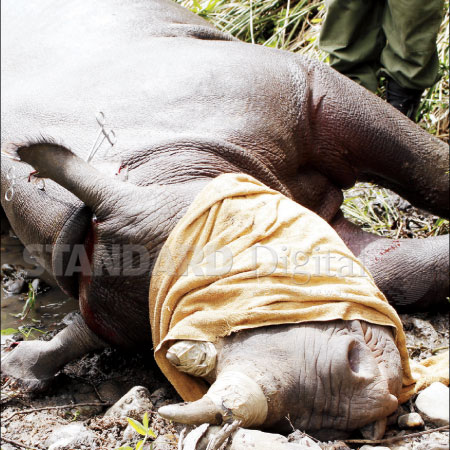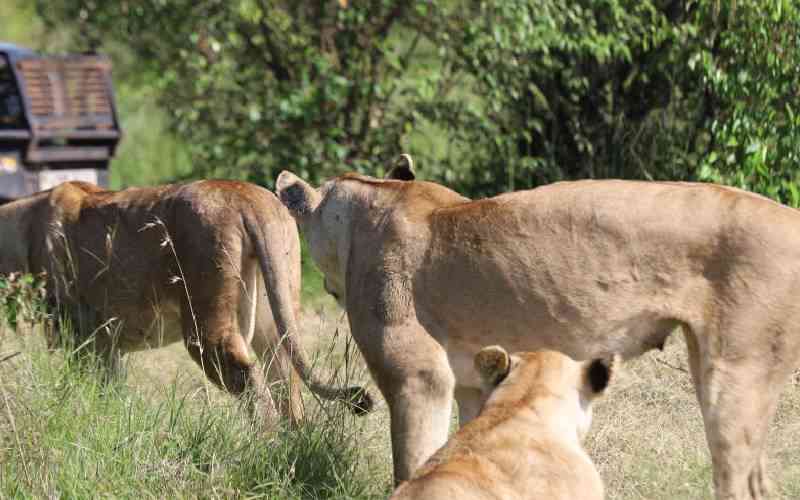 |
|
Kenya Wildlife Service rangers take a rhino’s DNA samples and put a notch on the animal’s ear at Masai Mara Game Reserve recently. The rhino ear-notching technology, is a strategy towards ending poaching. [PHOTO: KIPCHUMBA KEMEI/STANDARD] |
By KIPCHUMBA KEMEI
NAROK, KENYA: Kenya Wildlife Service (KWS) is now able to monitor rhino movement in the Maasai Mara Game Reserve following the installation of tracking devices on the animals.
A conservation agency spent Sh7 million on installing the anti-poaching gadgets that are expected to help boost the rhino population. The deployment of the microchips and ear-notching technology, combined with forensic DNA, which will later be rolled out in all national parks, game reserves and other wildlife sanctuaries across the country will allow 100 per cent tracking of every wild animal.
The World Wide Fund for Nature (WWF), the agency undertaking the exercise, said the rhino ear notching technology, is a strategy towards ending poaching.
WWF Country Director Mohammed Awer said the organisation together with the Zoological Society of London, other international donors and the private sector had put in place a strategy to support the end of poaching, strengthen monitoring and also support anti-trafficking mechanisms.
“We decided to launch the programme after realising that county governments, including Narok that manages the world famous Maasai Mara Game Reserve, are incapable of monitoring rhinos, which have been at the mercy of poachers, who roam about national parks, game reserves and other wildlife sanctuaries,” said Awer.
The fund, which is involved in species management and conservation, where rhinos fall, is working in partnership with KWS and Narok County government in the pilot programme, which targets about 50 rhinos inside and outside the protected areas of the Mara.
FLAGSHIP SPECIES
“Kenya is currently embracing the use of more advanced technology to counter illegal wildlife trade and stop the loss of flagship species such as rhino and elephants,” said Dr Isaac Lekolool, a senior veterinarian with KWS, who oversaw the exercise in the reserve last month.
He observed that forensic DNA technology will improve the ability of prosecutors to bring to courts cases of possession of wildlife trophies.
“It will also be used to trace back the rhino horns to a poaching incident, thus providing greater evidence hence more punitive measures,” Lekolool said.
Awer observed that since poachers are using advanced technology to beat authorities, it was time for Kenya to stay ahead of them.
He assured that WWF was committed to supporting the integration of the new technology.
About Sh2 million was spent on purchasing the microchips and Sh5 million on jet fuel for a KWS helicopter that was used in darting the animals.
A fixed wing plane that will monitor the rhino movement before the ear notching and insertion of the chips will also be fuelled.
Stay informed. Subscribe to our newsletter
ORGANISED CRIMES
WWF is a global conservation agency with a mission of conserving the world’s biological diversity. Awer said WWF and KWS have been working together since 1962 to ensure that Kenya meets the CITES Cop16 Rhino Decisions that seeks to ensure that the animal remains viable and survives current and future threats.
“The programme’s success will not only secure the rhino population in Kenya but it will also deliver improved governance and institutional strengthening within the Government. It will go a long way towards improving Government’s ability to combat other transnational organised crimes,” he said.
“It will also increase national and regional stability, all which create a more conducive environment and sustainable economic development,” he said at the launch of the exercise. Maasai Mara Game Reserve Chief Warden James Sindiyo said the new initiative would assist in monitoring rhino movements, which was difficult because of lack of vehicles, equipment, and personnel.
“Lack of modern technology has given poachers an upper hand. The new development will enhance efficiency and protect the surviving rhinos,” he said and added that the population of the animals had risen from 16, five years ago to about 50.
DNA SAMPLES
Sindiyo said the animals share the same ecosystem with Tanzania’s Serengeti. Their numbers have risen since 2009. He thanked Germany Zoology for donating a vehicle and monitoring equipment.
“The equipment has assisted us in knowing where the animals are. It has also assisted in dispensing medications,” he said.
Three years ago, Tanzania embraced the new technology. All the rhinos within that ecosystem have been notched and their DNA samples taken and it is now easy to monitor them.
 The Standard Group Plc is a
multi-media organization with investments in media platforms spanning newspaper
print operations, television, radio broadcasting, digital and online services. The
Standard Group is recognized as a leading multi-media house in Kenya with a key
influence in matters of national and international interest.
The Standard Group Plc is a
multi-media organization with investments in media platforms spanning newspaper
print operations, television, radio broadcasting, digital and online services. The
Standard Group is recognized as a leading multi-media house in Kenya with a key
influence in matters of national and international interest.
 The Standard Group Plc is a
multi-media organization with investments in media platforms spanning newspaper
print operations, television, radio broadcasting, digital and online services. The
Standard Group is recognized as a leading multi-media house in Kenya with a key
influence in matters of national and international interest.
The Standard Group Plc is a
multi-media organization with investments in media platforms spanning newspaper
print operations, television, radio broadcasting, digital and online services. The
Standard Group is recognized as a leading multi-media house in Kenya with a key
influence in matters of national and international interest.






